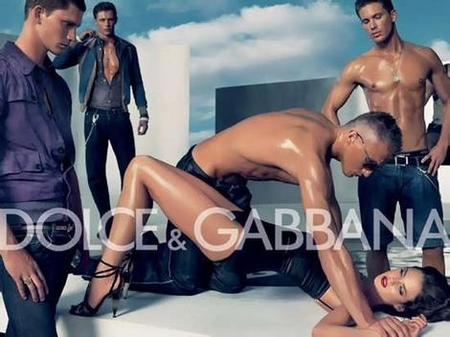Dolce and
Gabbana consistently use provocative adverts in an attempt to shock the public
and make their advertisements more memorable. Although studies have shown that shocking adverts can be
effective in influencing behaviour by increasing attention and memory (Dahl,
Frankenberger & Manchanda, 2003),
this particular advert sparked controversy as people felt it went too far in
violating social norms and was extremely offensive towards women. The males have adopted passive
aggressive stances towards the woman, who is portrayed in a submissive, cowering
role. She is powerless, being held down by one of the males and with an absent
look in her eyes. These kinds of
adverts, whilst designed purely to evoke emotion and be memorable, can be linked
to inspiring misogynistic views from men and leading woman to accept that they
will always be overpowered by men and should accept an obedient, subservient
role. The scene is very suggestive
with the implication of a ‘gang rape’ and in addition to promoting violence
against women, it is also glamorising it with the attractive, well-dressed
males. Therefore, I believe that
this is an ineffective advert as it is memorable for all the wrong reasons and
would stop people from purchasing items from Dolce and Gabbana in order to
distance themselves from the brand.
Ketelaar, van
Hemmen and Anshutz conducted a study in which female participants were shown a
sexually explicit advertisement in which a woman was used primarily as a sex
object. The participants then
completed a questionnaire, measuring their attitudes towards the portrayal of
women in advertisements and the effect those attitudes had on their view of the
company and their future purchase intention. It was found that although sexually objectifying advertisements
did not seem to negatively impact the company image or their purchase
intentions, adverts with high level of sexual objectification were deemed as
unethical and offensive and led participants to have a negative view of the
advert and consequently, the company.
The Dolce and Gabbana advertisement was clearly viewed as extremely
sexually offensive as, following complaints from consumers’ groups, it was
banned in both Spain and Italy.
Therefore, although the advertisement garnered a lot of publicity, many
people were highly offended by it and this reaction would have negatively
affected the company.
Dahl, D.W., Frankenberger, K.D. & Manchanda, R.V.
(2003). Does it pay to shock? Reactions to shocking and nonshocking
advertising content among university students. Journal of Advertising
Research, 43, 268-280.
Ketelaar, P. E.,
van Hemmen, S. & Anschutz, D. (2012). Sexist advertising: do women care?
Research into women’s attitudes towards sexual objectification in advertising
and its effect on general purchase intentions and company image. Journal of Communication Science, 40, 4-5.


Nice work.
ReplyDelete